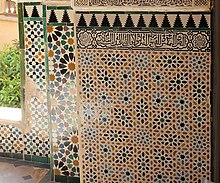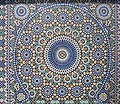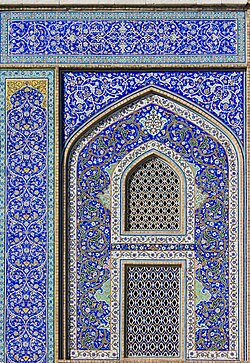A | B | C | D | E | F | G | H | CH | I | J | K | L | M | N | O | P | Q | R | S | T | U | V | W | X | Y | Z | 0 | 1 | 2 | 3 | 4 | 5 | 6 | 7 | 8 | 9

Zellij (Arabic: الزليج, romanized: zillīj; also spelled zillij or zellige) is a style of mosaic tilework made from individually hand-chiseled tile pieces set into a plaster base.[1] The pieces were typically of different colours and fitted together to form elaborate Islamic geometric motifs, such as radiating star patterns.[2][3] This form of Islamic art is one of the main characteristics of Moroccan architecture and the medieval Moorish architecture in the western Islamic world. Zellij became a standard decorative element along lower walls, in fountains and pools, and for the paving of floors.[2][3] It is found commonly in historic buildings throughout the region, as well as in modern buildings making use of traditional designs such as the Hassan II Mosque in Casablanca which adds a new color palette with traditional designs.[4]
Name
The word "zillīj" (زليج) is derived from the verb "zalaja" (زَلَجَ) meaning "to slide,"[5] in reference to the smooth, glazed surface of the tiles. The word "azulejo", a style of painted tile in Portugal and Spain of the same name, in Portuguese and Spanish derives from the word "zillīj".[6][7]
History

Zellij fragments from al-Mansuriyya (Sabra) in Tunisia, possibly dating from either the mid-10th century Fatimid foundation or from the mid-11th Zirid occupation, suggest that the technique may have developed in the western Islamic world around this period.[8] By the 11th century, the zellij technique had reached a sophisticated level in the western Islamic world, as attested in the elaborate pavements found at Qal'at Bani Hammad in Algeria.[8]
During the Almohad period, prominent bands of ceramic decoration in green and white were already features on the minarets of the Kutubiyya Mosque and the Kasbah Mosque of Marrakesh. Relatively simple in design, they may have reflected artistic influences from Sanhaja Berber culture.[9][3]: 231 Jonathan Bloom cites the white and green glazed tiles on the minaret of the Kutubiyya Mosque, dating from the mid-12th century in the early Almohad period, as the earliest reliably-dated example of zellij in Morocco.[10]: 26

The more complex zellij style that we know today became widespread by the 14th century during the Marinid, Nasrid, and Zayyanid dynastic periods in Morocco, Algeria, al-Andalus, and the wider Maghreb.[3][2] It may have been inspired or derived from Byzantine mosaics and then adapted by Muslim craftsmen for faience tiles.[2] Due to the significant cultural unity and relations between the al-Andalus and the western Maghreb, the forms of zellij under Marinid, Nasrid, and Zayyanid patronage are extremely similar.[11]: 188–189 Geometric patterns and other motifs of increasing complexity were formed. This style is evident in famous buildings of the period such as the Alhambra palaces of the Nasrids and the Marinid madrasas of Fes, Meknes, and Salé. By this period, more colours were employed such as yellow (using iron oxides or chrome yellow), blues, and a dark brown manganese colour.[3]: 336 This form of expression within the conceptual framework of Islamic art valued the creation of spatial decorations that avoided depictions of living things, consistent with taboos of aniconism in Islam on such depictions.[2]
Among the most exceptional surviving examples of Nasrid zellij art are the dadoes of the Mirador de Lindaraja and the Torre de la Cautiva in the Alhambra. Whereas Arabic epigraphy in tilework was usually painted on larger square tiles, these two examples contain very fine Arabic inscriptions in Naskhi script that are made from the assembly of coloured tile pieces cut in the form of the letters themselves and set into a white background.[12] The tiles of the Torre de la Cautiva are further distinguished by the use of a purple colour which is unique in architectural zellij decoration.[12] The dado of the Mirador of Lindaraja also contains a particularly advanced geometric composition with fine mosaic pieces below the level of the inscription.[13] In addition to zellij work further west, a somewhat distinctive style of zellij with brightly coloured pieces, often in floral patterns of palmettes and scrollwork, developed among the craftsmen of Tlemcen. The most important early example of this style was the decoration of the Tashfiniya Madrasa (no longer extant), founded by Abu Tashfin I (r. 1318–1337). This type subsequently appeared in later monuments of this era, mainly in Tlemcen (such as the Mosque of Abu Madyan) but also further afield in the Marinid madrasa of Chellah, suggesting that the same workshop of craftsmen may have been employed by the Marinids around this time.[11]: 187, 195, 206 [14]: 526 [15]

Under the Saadian dynasty in the 16th century and in subsequent centuries, the usage of zellij became even more widespread and ubiquitous as decoration. The complexity of geometric patterns increased in part through the use of even finer (thinner) mosaic pieces for some compositions, though in some cases this came at the expense of more colours.[3]: 414–415 The zellij compositions in the Saadian Tombs are considered one of the best examples of this type.[16][3] Red pigment was added in the 17th century.[citation needed]
The old enamels with the natural colours were used until the beginning of the 20th century and the colours had probably not evolved much since the period of Marinids.[citation needed] The cities of Fes and Meknes in Morocco, remain the centers of this art.[citation needed]
Clays for zellīj
Fez and Meknes in Morocco are still the production centers for zellīj tiles due to the Miocene grey clay of Fez. The clay from this region is primarily composed of kaolinite. For Fez and Meknes, the clay composition is 2–56% clay minerals, of which 3–29% is calcite. Meriam El Ouahabi states that:
From the other sites (Meknes, Fes, Salé and Safi), the clay mineral composition shows besides kaolinite the presence of illite, chlorite, smectite and traces of mixed layer illite/chlorite. Meknes clays belong to illitic clays, characterized by illite (54 – 61%), kaolinite (11 – 43%), smectite (8 – 12%) and chlorite (6 – 19%). Fes clays have a homogeneous composition with illite (40 – 48%). and kaolinite (18 – 28%) as the most abundant clay minerals. Chlorite (12 – 15%) and smectite (9 – 12%) are generally present as small quantities. Mixed layer illite/chlorite is present in trace amounts in all the examined Fes clay materials.[17]
Forms and trends

As the colour palette of the zellīj tiles increased over the centuries, it became possible to multiply the compositions ad infinitum. The most current form of the zellīj is a square. Other forms are possible: the octagon combined with a cabochon, a star, a cross, etc. It is then moulded with a thickness of approximately 2 centimetres. There are simple squares of 10 by 10 centimeters or with the corners cut to be combined with a coloured cabochon. To pave an area, bejmat, a paving stone of 15 by 5 centimetres approximately and 2 centimetres thick, can also be used.[citation needed]
An encyclopedia could not contain the full array of complex, often individually varied patterns and the individually shaped, hand-cut tesserae, or furmah, found in zillij work. Star-based patterns are identified by their number of points—'itnashari for 12, 'ishrini for 20, arba' wa 'ishrini for 24 and so on, but they are not necessarily named with exactitude. The so-called khamsini, for 50 points, and mi'ini, for 100, actually consist of 48 and 96 points respectively, because geometry requires that the number of points of any star in this sequence be divisible by six. (There are also sequences based on five and on eight.) Within a single star pattern, variations abound—by the mix of colors, the size of the furmah, and the complexity and size of interspacing elements such as strapping, braids, or "lanterns." And then there are all the non-star patterns— honeycombs, webs, steps and shoulders, and checkerboards. The Alhambra's interlocking zillij patterns were reportedly a source of inspiration for the tessellations of modern Dutch artist M.C. Escher.[18]
Themes often employ Kufic script, as it fits well with the geometry of the mosaic tiles, and patterns often culminate centrally in the Rub El Hizb. The tessellations in the mosaics are currently of interest in academic research in the mathematics of art.
Zellij paving around the fountain of the Al-Attarine Madrasa (14th century)
Zellij applied to curved surfaces in the Marinid Madrasa of Salé (14th century)
Zellij details on the minaret of the Marinid-era Chrabliyine Mosque in Fes
Zellij fragment from Tilemsan, Algeria, from the 14th century.
Ben Youssef Madrasa in Marrakesh
Detail of Bab al-Mansour in Meknes (early 18th century)
20th-century zellij in the Mahkamat al-Pasha in Casablanca, Morocco
Edmond Brion's reinterpreted zellij at Bank Al-Maghrib in Casablanca
These studies require expertise not only in the fields of mathematics, art and art history, but also of computer science, computer modelling and software engineering,[19] all used for the Hassan II Mosque.
Islamic decoration and craftsmanship had a significant influence on Western art when Venetian merchants brought goods of many types back to Italy from the 14th century onwards.[20]
Zellīj craftsmanship
Zellīj making is considered an art in itself. The art is transmitted from generation to generation by maâlems (master craftsmen). A long training starts at childhood to implant the required skills.[21] In 1993, the Moroccan government abolished the practice of teaching young children starting at ages 5 to 7, when the Convention on the Rights of the Child (CRC) was ratified.[22] Now young people learn zellīj making at one of the 58 artisan schools in Morocco. However, the interest in learning the craft is dropping. As of 2018, at an artisan school in Fez with 400 enrolled students only 7 students learn how to make zellīj.[23]
Zellij tiles are first fabricated in glazed squares, typically 10 cm per side, then cut by hand into a variety of pre-established shapes (usually memorized by rote learning) necessary to form the overall pattern.[24][3]: 414 Although the exact patterns vary from case to case, the underlying principles have been constant for centuries and Moroccan craftsmen are still adept at making them today.[24] The small shapes (cut according to a precise radius gauge), painted and enamel covered pieces are then assembled in a geometrical structure as in a puzzle to form the completed mosaic. The process has not varied for a millennium, though conception and design has started using new technologies such as data processing.[citation needed]
Artisan workers chipping zellij pieces, Fez, Morocco.
Further reading
- at-Tanwīr wa-Diwān at-Tahbīr fi Fan at-Tastīr (التنوير وديوان التحبير في فن التسطير) by Khalid Saib (in Arabic)[25]
See also
References
Citations
- ^ L'Opinion (May 6, 1992)
- ^ a b c d e Touri, Abdelaziz; Benaboud, Mhammad; Boujibar El-Khatib, Naïma; Lakhdar, Kamal; Mezzine, Mohamed (2010). Le Maroc andalou : à la découverte d'un art de vivre (2 ed.). Ministère des Affaires Culturelles du Royaume du Maroc & Museum With No Frontiers. ISBN 978-3902782311.
- ^ a b c d e f g h Marçais, Georges (1954). L'architecture musulmane d'Occident. Paris: Arts et métiers graphiques.
- ^ Broug, Eric (2008). Islamic Geometric Patterns. London: Thames & Hudson. ISBN 978-0-500-28721-7.
- ^ Team, Almaany. "تعريف و شرح و معنى زليج بالعربي في معاجم اللغة العربية معجم المعاني الجامع، المعجم الوسيط ،اللغة العربية المعاصرة ،الرائد ،لسان العرب ،القاموس المحيط - معجم عربي عربي صفحة 1". www.almaany.com. Retrieved 2020-05-29.
- ^ "azulejo – definition of azulejo in Spanish". Oxford Living Dictionaries. Oxford University Press. Archived from the original on 8 April 2019. Retrieved 8 April 2020.
- ^ "Azulejos: gallery and history of handmade Portuguese and Spanish tiles". www.azulejos.fr. Retrieved 8 April 2020.
- ^ a b Jonathan Bloom; Sheila S. Blair; Sheila Blair (2009). "Architecture; X. Decoration; B. Tiles". Grove Encyclopedia of Islamic Art & Architecture. Oxford University Press. p. 201. ISBN 978-0-19-530991-1.
- ^ Lintz, Yannick; Déléry, Claire; Tuil Leonetti, Bulle, eds. (2014). Maroc médiéval: Un empire de l'Afrique à l'Espagne. Paris: Louvre éditions. ISBN 9782350314907.
- ^ Bloom, Jonathan; Toufiq, Ahmed; Carboni, Stefano; Soultanian, Jack; Wilmering, Antoine M.; Minor, Mark D.; Zawacki, Andrew; Hbibi, El Mostafa (1998). The Minbar from the Kutubiyya Mosque. The Metropolitan Museum of Art, New York; Ediciones El Viso, S.A., Madrid; Ministère des Affaires Culturelles, Royaume du Maroc.
- ^ a b c Bloom, Jonathan M. (2020). Architecture of the Islamic West: North Africa and the Iberian Peninsula, 700–1800. Yale University Press. ISBN 9780300218701.
- ^ a b López, Jesús Bermúdez (2011). The Alhambra and the Generalife: Official Guide. TF Editores. pp. 146, 195–196. ISBN 9788492441129.
- ^ Makovicky, Emil (2016-08-22). Symmetry: Through the Eyes of Old Masters. Walter de Gruyter GmbH & Co KG. ISBN 978-3-11-041719-7.
- ^ Lintz, Yannick; Déléry, Claire; Tuil Leonetti, Bulle (2014). Maroc médiéval: Un empire de l'Afrique à l'Espagne. Paris: Louvre éditions. ISBN 9782350314907.
- ^ Charpentier, Agnès (2018). Tlemcen médiévale: urbanisme, architecture et arts (in French). Éditions de Boccard. ISBN 9782701805252.
- ^ Salmon, Xavier (2016). Marrakech: Splendeurs saadiennes: 1550-1650. Paris: LienArt. ISBN 9782359061826.
- ^ El Ouahabi, Meriam (2014). "Mineralogical and geotechnical characterization of clays from northern Morocco for their potential use in the ceramic industry". Clay Minerals. 49 (1): 35–51. Bibcode:2014ClMin..49...35O. doi:10.1180/claymin.2014.049.1.04. S2CID 131441497.
- ^ Werner, Louis. 2001. "Zillij in Fez." Saudi Aramco World. May–June 2001. Volume 52 (3). Pages 18–31.
- ^ From Form to Content: Using Shape Grammars for Image Visualization, Source IV archive Proceedings of the Ninth International Conference on Information Visualisation (IV'05) – Volume 00, IEEE Computer Society Washington, DC, USA
- ^ Mack, Rosamond E. (2001). Bazaar to Piazza: Islamic Trade and Italian Art, 1300-1600. University of California Press. pp. Chapter 1. ISBN 0-520-22131-1.
- ^ beton-decoratif.com
- ^ "Lonely Servitude | Child Domestic Labor in Morocco". Human Rights Watch. 2012-11-15. Retrieved 2019-05-22.
- ^ "Crafting mosaic tile is an endangered tradition. Here are the folks keeping it alive". USA TODAY. Retrieved 2019-05-22.
- ^ a b Parker, Richard (1981). A practical guide to Islamic Monuments in Morocco. Charlottesville, VA: The Baraka Press.
- ^ خالد،, السايب، (2016). كتاب التنوير وديوان التحبير في فن التسطير (in Arabic). ISBN 978-9954-37-649-2.
Sources
- Some of the content of this article comes from the equivalent French-language Wikipedia article, accessed January 3, 2007.
- Moroccan Ceramics and the Geography of Invented Traditions, Journal article by James E. Housefield; The Geographical Review, Vol. 86, 1997
- The Elements of Unity in Islamic Art As Examined Through the Work of Jamal Badran, By Fayeq S Oweis
- Engineering and fine arts research collaborations sprout from seed grants, By Scott McRae, Concordia's Thursday Report, Vol. 29, No.1, September 9, 2004
- Technical Glossary, Islamic Art Network, Thesarus Islamicus Foundation, Islamic Art Network 21 Misr Helwan al-Ziraa‘i St., 9th Floor, Al-Ma'adi, Cairo, Egypt
External links
>Text je dostupný pod licencí Creative Commons Uveďte autora – Zachovejte licenci, případně za dalších podmínek. Podrobnosti naleznete na stránce Podmínky užití.
Text je dostupný za podmienok Creative
Commons Attribution/Share-Alike License 3.0 Unported; prípadne za ďalších
podmienok.
Podrobnejšie informácie nájdete na stránke Podmienky
použitia.























